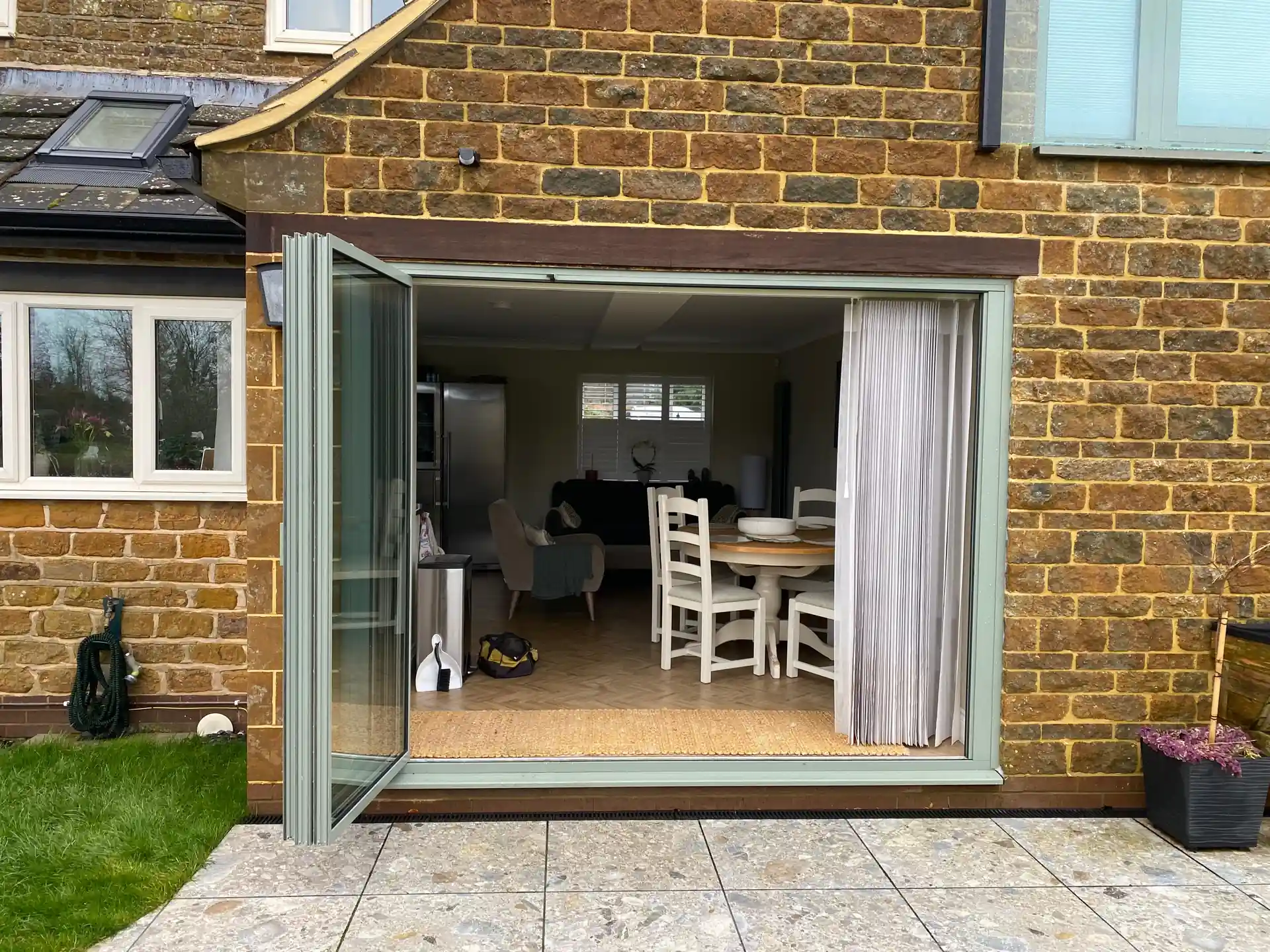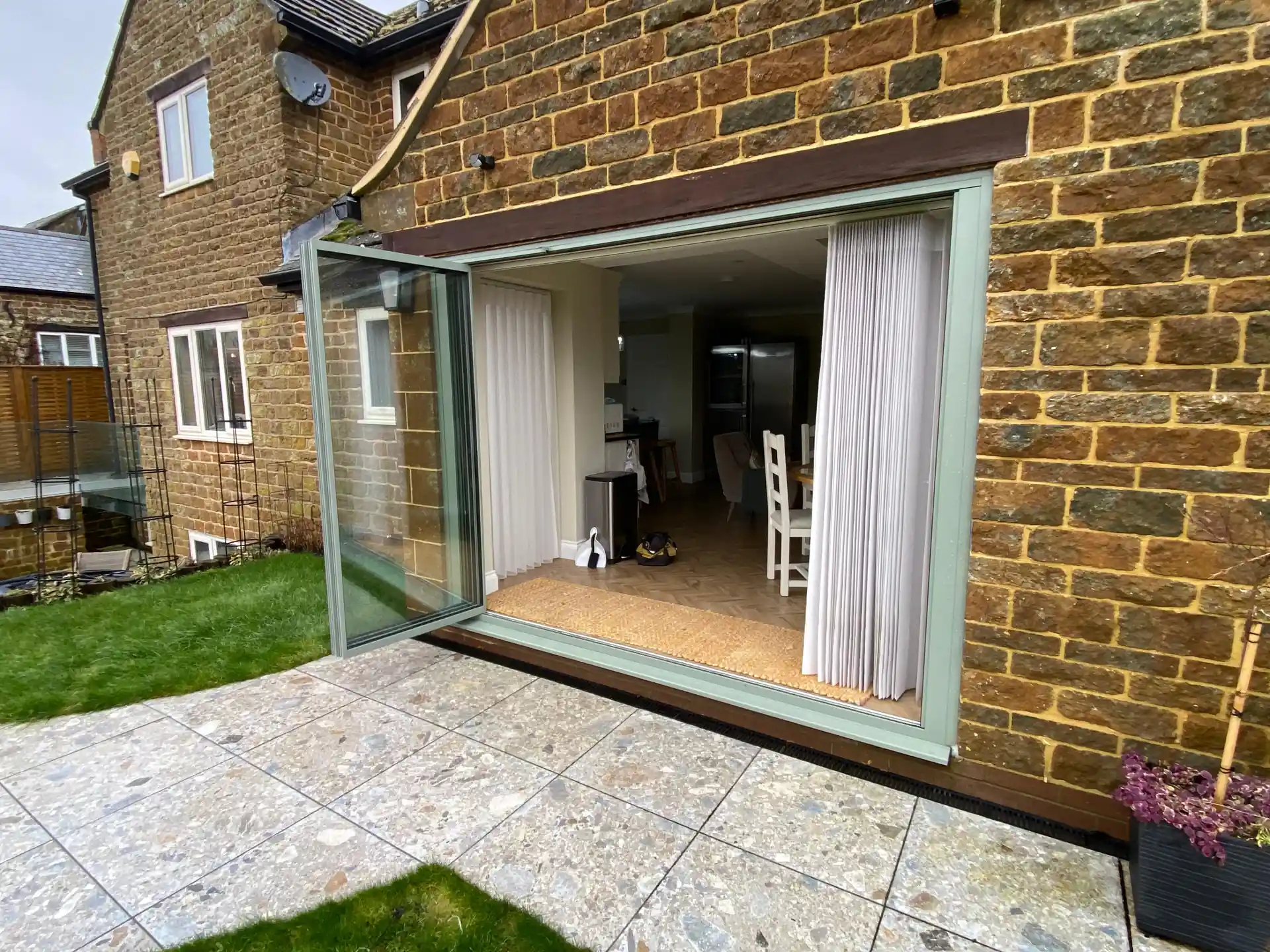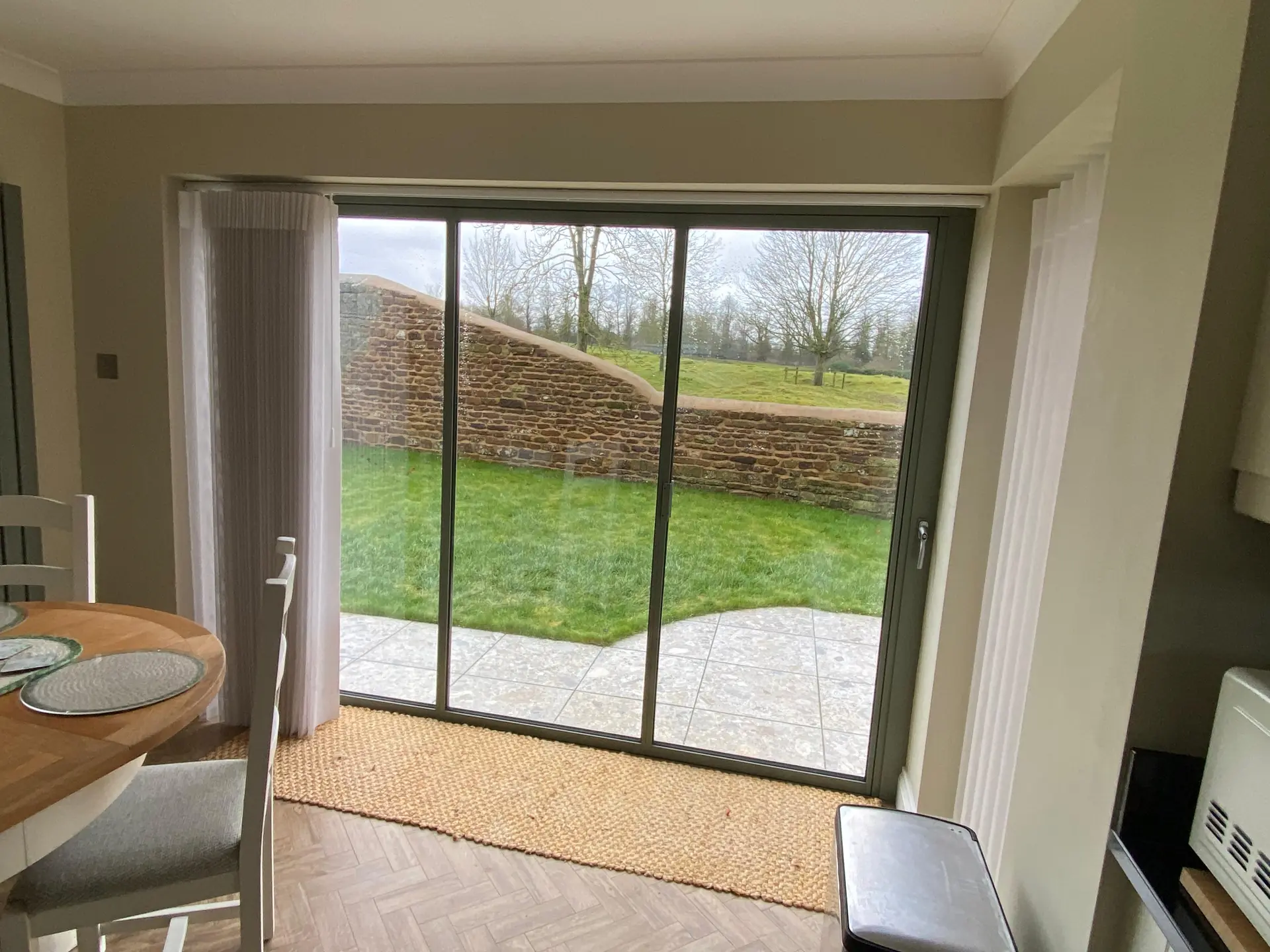Sage Green Bifold Doors: Hardware & Colour Guide
Table of Contents

The Psychology of Sage Green Bifold Doors
Sage green bifold doors blend natural beauty with practical design, striking a balance between modern architecture and organic charm. Drawing from centuries of colour psychology research, sage green ranks among the most calming shades in architectural design, making it particularly well-suited for bi-folding doors that serve as both visual centrepieces and functional room dividers.

Natural Light Effects
Morning sunlight brings out sage green bifold doors’ warmer undertones, casting a gentle glow across living spaces. As daylight shifts throughout the day, the panels take on different personalities – bright and fresh at midday, soft and muted during sunset. Slimline bifold doors in sage green demonstrate this quality especially well, their minimal frames allowing the colour to respond more to changing light conditions.
Emotional Impact
Rather than overwhelming the senses like brighter greens, sage creates a measured sense of calm in any room.
The gentle undertones of grey within sage green folding doors help ground the space, while subtle hints of blue foster mental clarity. Painted bi-fold doors in this shade provide a gentle backdrop that reduces visual noise without fading into the background.
Visual Weight
Sage’s innate connection to the natural world helps coloured bifold doors feel purposeful rather than imposing. The depth of sage green means these doors hold their own as design features while complementing rather than competing with surrounding decor. When light hits the surface, subtle variations emerge within the paint, creating visual interest that draws the eye without demanding attention.
Colour Science
The specific wavelengths of sage green occupy a sweet spot in human colour perception – neither too stimulating nor too subdued. This careful balance explains why sage green bifold doors work equally well in both active spaces like kitchens and relaxing areas such as living rooms or bedrooms. The slight grey undertones in sage provide sophistication while its green base maintains a connection to nature.
Sage Green Bifold Doors in Different Homes
Period properties and modern builds each bring unique opportunities for sage green bifold doors. Rather than creating a stark contrast, sage softens architectural lines while adding subtle character to the space.
Period Properties
Victorian and Georgian homes present perfect settings for sage green bifold doors, particularly in renovated rear extensions where original features meet modern design. Deep skirting boards and ornate cornicing gain a fresh perspective when paired with sage, creating visual harmony rather than competition between old and new. Lighter sage tones work especially well in properties with detailed architectural elements, preventing the space from feeling heavy or closed in.
The growing trend for bespoke colours in period renovations has made sage green a natural choice for homeowners seeking to maintain historical authenticity. Original Victorian paint schemes often featured muted greens, making sage green folding doors feel appropriate rather than anachronistic. Darker wood floors typical of period properties provide strong foundations for this shade, while original brass fixtures complement the natural undertones.
Heritage Features
Crown mouldings and ceiling roses take on new life when viewed against sage green doors. The colour’s subtle variations mirror the play of light across detailed plasterwork, drawing attention to these heritage features without overshadowing them. In rooms with original fireplaces, sage provides a sophisticated backdrop that allows these focal points to shine.
Modern Builds
Contemporary architecture benefits from slim profile bifold doors in sage green, where clean lines and minimalist design principles prevail. The colour adds warmth to modern spaces that might otherwise feel stark or clinical. Angular furniture and polished concrete floors find balance against the natural qualities of sage, while metal fixtures in chrome or black create striking definition against the painted frames.
Open-plan layouts particularly suit sage green bifold doors, as the colour helps define different zones without requiring physical barriers. The shade works equally well in double-height spaces, where it helps ground expansive walls without feeling overwhelming. Modern homes with large glazed areas benefit from sage’s ability to bridge the gap between structural elements and garden views.
Garden Rooms
Garden rooms present ideal opportunities for sage green bifold doors, creating natural continuity with outdoor spaces. The colour echoes garden foliage while maintaining its own distinct identity throughout changing seasons. North-facing garden rooms particularly benefit from sage’s reflective properties, helping brighten spaces that might lack direct sunlight.
Glass kitchen doors in sage green prove especially effective in garden room extensions, where cooking and dining areas connect with outdoor living spaces. The colour maintains its appeal across different times of day, from bright morning light to evening sunshine. Herb gardens and kitchen gardens gain extra resonance when viewed through sage-coloured frames, creating pleasant visual connections between growing spaces and preparation areas.
Plants thrive visually against sage backdrops – from trailing ivy to architectural palms. The neutral undertones in sage green complement most leaf colours without competing for attention. Garden room furniture in natural materials like rattan or teak finds an ideal partner in sage green bifold doors, as do contemporary pieces in clear glass or brushed metal.
Creating Colour Harmony
Choosing the right accompanying colours amplifies the natural charm of sage green bifold doors. Paint shades, furniture finishes, and textiles each play distinct parts in building a cohesive scheme around this flexible hue.

Wall Colours
Deep navy walls create striking backdrops for sage green bifold doors, particularly in spaces that receive plenty of natural light. The richness of dark blue brings out sage’s grey undertones while maintaining a sophisticated atmosphere. Warm whites work equally well, letting sage green folding doors become focal points without overwhelming the space.
Earthy terracotta adds warmth when used on walls adjacent to sage green doors, creating an organic palette that feels grounded yet fresh. This combination proves particularly effective in kitchen extensions, where the interplay of colours adds depth to eating and cooking areas. Pale stone greys offer another compelling option, their cool undertones complementing sage’s natural qualities while maintaining visual interest.
Neutral Foundations
Popular colours for walls near bifold doors tend toward the neutral spectrum, but sage green opens up possibilities for more adventurous choices. Soft pinks create unexpected harmony with sage, their warm undertones balancing the cool elements in the green. Gentle ochre shades introduce subtle warmth without competing for attention, while pure white walls let sage green bifold doors stand as statement pieces.
Garden Connections
Gardens with silver-leafed plants like lavender or artemisia mirror the grey notes in sage green bifold doors beautifully. Purple flowers provide natural contrast, while white blooms create bright spots that draw the eye outward. Ornamental grasses planted near the doors catch light and movement, their shifting colours playing against the steady tone of sage.
Evergreen shrubs maintain year-round connection with sage green doors, their varied foliage creating layers of green that feel intentional rather than repetitive. Winter gardens particularly benefit from this relationship, as sage provides a steady colour anchor when other plants lose their leaves. Spring bulbs bursting into bloom find perfect framing through sage green bifold doors, their bright colours popping against the muted background.
Monochromatic Schemes
Building depth through varying shades of green creates sophisticated interiors that feel carefully planned rather than matchy. Darker forest greens on soft furnishings ground the space, while lighter mint accents add brightness without jarring. Sage green bifold doors sit comfortably at the centre of these tonal arrangements, providing a middle note that ties different elements together.
Textiles in closely related greens – from cushions to curtains – help develop the monochromatic theme without making spaces feel flat. Natural materials like wool and linen add texture through their weave, preventing the green palette from appearing too uniform. Plants bring living elements to these schemes, their organic shapes and shifting shadows creating movement against solid blocks of colour.
Styling Your Sage Green Bifold Doors
Hardware and styling elements shape the final appearance of sage green bifold doors in distinctive ways. From metallic finishes to furniture placement, each design choice builds upon the natural qualities of this enduring shade.
Hardware Choices
Brushed brass hardware brings warmth to sage green folding doors, creating a classic look that suits period properties and modern homes alike. The subtle sheen of brass catches light differently throughout the day, adding visual interest without overpowering the soft green tones. Matte black handles and hinges offer sharp contrast, defining each panel while maintaining a contemporary edge.
Stainless steel fixtures work particularly well with powder coated aluminium doors, their cool tones echoing the grey undertones in sage. Chrome hardware creates bright points of interest that draw attention to the smooth operation of each panel. For a more industrial look, raw steel or iron fixtures add rugged character while complementing sage’s natural qualities.
Frame Options
Frame design influences how sage appears across different lighting conditions. Slimmer frames let more light play across the painted surface, while chunkier profiles create deeper shadows that bring out sage’s darker notes. Dual colour doors with sage green external faces paired with white internal frames offer practical flexibility for rooms where different colour schemes meet.

Room Layout
Sage green bifold doors shine in spaces arranged to highlight their presence. Living room seating positioned at slight angles to the doors creates inviting sight lines while maintaining practical traffic flow. Kitchen islands parallel to door panels establish natural pathways between cooking and outdoor areas.
Dining tables placed near sage green bifold doors benefit from changing natural light throughout meals. The calming properties of sage provide pleasant backdrops for long dinners, while morning light streaming through the panels energises breakfast spaces. Reading nooks and workspaces gain peaceful atmospheres when tucked beside these doors, especially when furnished with pieces that pick up sage’s natural undertones.
Materials and Textures
Raw timber furniture brings organic warmth to rooms featuring sage green bifold doors. Oak’s honey tones provide beautiful contrast, while walnut’s deeper shades add richness to the overall scheme. Painted wooden pieces in complementary colours – from pale greys to deep blues – help build layered interest throughout the space.
Natural stone flooring carries sage’s organic qualities downward, whether through limestone’s pale tones or slate’s deeper hues. Terrazzo with green chips subtly references the door colour while adding pattern and movement to the floor plane. Polished concrete provides industrial edge without competing with sage’s sophistication, its surface reflecting light in ways that complement the doors’ finish.
Light and Space with Sage Green Bifolds
Different lighting conditions bring out varying qualities in sage green bifold doors throughout the day and across seasons. The paint’s subtle undertones respond to natural and artificial light in ways that change the character of living spaces.
North-Facing Spaces
North-facing rooms present unique opportunities for sage green folding doors to improve light quality. The gentle grey undertones in sage help reflect available light back into the space, while the green elements add warmth to cooler northern light. Morning sun striking the doors at an angle creates soft shadows that add depth to otherwise flat-looking spaces.
Wall-mounted lighting placed strategically near sage green bifold doors helps maintain their visual impact after sunset. Uplighters wash the painted surface with warm light, bringing out the colour’s richer tones. Track lighting aimed across the panels creates interesting shadow play while highlighting the doors’ architectural qualities.
Pale floor finishes near the doors bounce light upward, making north-facing spaces feel brighter and more open. Light-coloured rugs laid parallel to the door panels help carry daylight deeper into the room. Mirrors positioned to catch and reflect light from the doors multiply the available illumination while creating interesting views of the sage green surfaces.
Compact Areas
Small spaces gain distinct advantages from sage green bifold doors. The colour’s natural qualities prevent it from overpowering limited square footage, while its light-reflecting properties make tight areas feel more spacious. Compact doors in sage green prove particularly effective in small extensions, where every centimetre counts.
Furniture scaled appropriately to smaller spaces works in harmony with sage green doors. Low-profile seating allows the doors to remain prominent features without cramping the room. Wall-mounted storage keeps floor space clear while providing opportunities to echo sage green in smaller doses through painted shelving or cabinet doors.
Layout Strategies
Corner sofas positioned to face sage green bifold doors create comfortable seating areas that maintain clear sight lines. Coffee tables with glass tops or pale finishes avoid blocking light paths through the space. Nesting tables tucked against walls provide flexibility for entertaining without permanently reducing usable floor area.
Commercial Settings
Cafés featuring sage green bifold doors create pleasant atmospheres that welcome customers throughout the day. The colour’s association with nature and wellness resonates particularly well in health-focused eateries and juice bars. Morning sunlight filtering through sage panels sets peaceful moods for early customers, while evening light brings out warmer tones during dinner service.
Creative studios benefit from the steady, calming presence of sage green doors. The colour provides neutral backdrops for artwork or product displays without competing for attention. Photography studios particularly value sage’s ability to reflect light evenly, creating pleasant ambient conditions for shoots.
Retail spaces use sage green bifold doors to craft inviting entrances that stand out from standard shopfronts. The colour’s sophistication suits high-end boutiques, while its natural associations work well for florists and plant shops. Seasonal merchandise displays coordinate easily with sage, from summer brights to winter neutrals.
Wellness spaces like yoga studios and spas find natural allies in sage green doors. The colour promotes relaxation while maintaining professional appearances. Treatment rooms adjacent to sage green bifold doors gain peaceful atmospheres that support client comfort. Meeting rooms and consultation spaces benefit from the colour’s ability to put people at ease while maintaining focus.
We’d Love to Help You
Vision Glass Doors is a designer, manufacturer, and installer of premium door systems. We are a family run business with over 20 years’ experience and 5,000 installations across the UK.
Our leading range of door systems include Ultra Slim – Slide and Turn Doors, Slimline Sliding Patio Doors and Frameless Glass Doors. Suitable for various internal and external applications, they are applicable to residential and commercial projects.
Click Quick Quote Online for a free quotation within 24 hours. Alternatively, call or email us on 01582 492730 or at info@visionglassdoors.co.uk.

